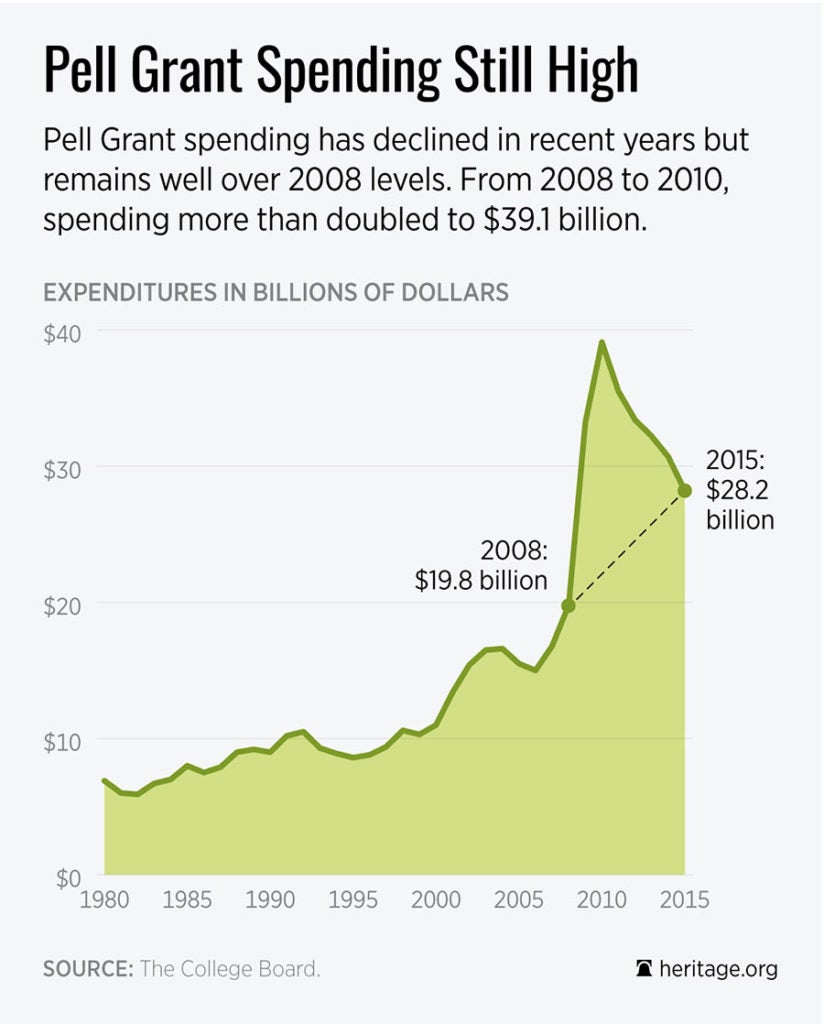The Trump administration’s proposed budget blueprint for 2018 significantly cuts waste in federal higher education spending.
For decades, the federal government has increased spending on higher education programs with not much to show for it—other than higher tuition prices.
Today, American students and taxpayers are in bad shape when it comes to college costs. The U.S. has $1.3 trillion in outstanding student loan debt, most recent graduates are not paying off their loans, and taxpayers are projected to forgive $108 billion in student loans over the next 10 years due to loan forgiveness programs alone.
Needless to say, change to the higher education spending status quo is welcome news. Along with significant spending cuts to wasteful K-12 programs, the 2018 budget proposal does the following:
- Eliminates the Federal Supplemental Educational Opportunity Grant program.
As implied by the name, the Federal Supplemental Education Opportunity Grant program simply supplements the already generous Pell Grant program, which offers funding for low-income students to attend college. This redundant federal spending is, as the 2018 Blueprint puts it, “a less well-targeted way to deliver need-based aid than the Pell Grant program.”
- Cuts wasteful Pell Grant funding.
Funding for the Pell Grant program skyrocketed under the Obama administration. In 2010-2011, the Department of Education spent $39.1 billion on the Pell Grant program, compared to $15.5 billion in 2005-2006.
The Trump administration’s 2018 budget would cut the program by $3.9 billion, which the administration notes would put the Pell Grant program on more solid financial footing for the next 10 years. While the program is still expansive—due in part to expanded eligibility—this budget cut is a significant first step in restoring pre-2008 funding levels (the point at which the program doubled in size).
- Reduces funding for TRiO programs and GEAR UP.
The Trump administration’s budget cuts $193 million from the Federal TRIO programs and Gaining Early Awareness and Readiness for Undergraduate Programs (GEAR UP)—programs targeted to low-income students that have shown little effectiveness over the years.
Federal TRiO programs are intended to help students of disadvantaged backgrounds attend college. Though well-intentioned, these programs have shown little evidence in helping first-generation, low-income students or students with disabilities gain access to higher education.
Similarly, GEAR UP, which is specifically geared toward low-income students, is a redundant program with a sub-par record of accomplishment. A 2013 Brookings Institution report indicated that federal college prep programs “show no major effects on college enrollment or completion,” despite the annual $1 billion investment.
- Reins in the Federal Work-Study Program.
The Federal Work-Study Program, in which students engage in federally funded jobs on or off campus often while using federal student loans, has led to a spider web of taxpayer dollars subsidizing the college experience.
Although working while in school does help students finance their education, it does not justify a federal program. Additionally, Inside Higher Ed has reported that wealthier students are actually more likely to benefit from Federal Work-Study than the low-income students the program was intended to help.
The president’s proposed budget cuts in the Federal Work-Study Program could help streamline those funds to low-income students who are most in need of assistance.
Overall, this budget lowers discretionary spending at the Department of Education from $68 billion to $59 billion. This is welcome news to taxpayers who have seen the size and scope of the Department of Education grow exponentially since its inception in 1979.
The president’s proposed cuts in wasteful spending on higher education programs is an important step in restoring financial responsibility in Washington and ending the higher education spending spree.






























